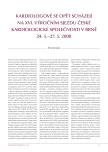Post-stroke rehabilitation
Authors:
J. Mikula
Authors‘ workplace:
Rehabilitační sanatorium Karviná – Lázně Darkov, a. s.
Published in:
Kardiol Rev Int Med 2008, 10(2): 66-73
Overview
It is essential that timely and permanent prevention of contractures should start from the onset of a cerebrovascular accident (CVA). The objective of rehabilitation in spastics is to provoke reciprocal relaxation of the antagonist through agonist muscle contraction, while in hemiplegics gentle tactile and proprioceptive stimulation is used carefully to increase postural activity. The article discusses a variety of procedures that can be used to infl uence spastic syndrome. Topic areas include gait training for hemiparetics, the renewal of functional knee control in limb paresis, adaptation to vertical position and leg training. A treadmill is very useful equipment in gait training. Alongside gait rehabilitation, training of the arms is another important part of the rehabilitation of such patients. Alongside gait rehabilitation, training of the arms is another important part of the rehabilitation of such patients. Another indispensable treatment is conditioning, making use of four general principles of facilitation, i.e. PNF techniques, activation of the muscles in a given movement chain, activation of the limbic system and transcallosal facilitation. Hippotheray is a practical means of applying re-education methods, in which numerous facilitatory mechanisms are activated. A modern and highly-promising approach is to combine computer technology with precise diagnosis of damage to laterolateral and anteroposterial structures and subsequent targeted vestibular habituation exercises. It involves the use of stabilometric platforms, whose basic function is the computer analysis of vestibulospinal postural refl exive actions and an analysis of the movement vectors of the centre of gravity in eight directional axes. Stabilometry and static posturography facilitate the differential diagnosis of dizziness and a great variety of defects in spatial orientation and are a component of complex modern rehabilitation for hemiparetics. The methodology for post-stroke rehabilitation as a whole is an extensive and complex discipline. This work merely identifi es its basic principles and a number of new options.
Key words:
spastic syndrome – refl ex inhibition patterns – functional knee control – gait rehabilitation – arm training –
principles of facilitation – hippotherapy – stabilometry – posturography – vestibular habituation exercises
Sources
1.Drobný M, Michalik J, Kurča E et al. Neiktové ďalšie okolnosti a riziká ovplyvňujúce osud pacientov s CMP. Čes Slov Neurol Neurochir 2000; 3: 134-140.
2.Somorová J. Hodnotenie motorického deficitu u pacientov po NCMP podľa Signe Brunnstromovej. Rehabilitácia 1993; 26(2): 103-116.
3.Bobathovi B. Hemiplegia dospelých. Bratislava: Lečreh gúth 1997.
4.Benetin J, Kuchar M. Liečba spastického syndrómu. Rehabilitácia 1997; 30(4): 243-246.
5.Seidel EJ, Wick C, Günther P, Tentscher J. Nová analgeticky pôsobiaca fyzikálna terapia. Rehabilitácia 1995; 28(2): 79-83.
6.Ammer K, Rathkolb O. Liečba biofeedbackom při neurologických ochoreniach a bolestiach hlavy. Rehabilitácia 1997; 30(4): 237-242.
7.Dietz V, Harkema SJ. Locomotor activity in spinal cord-injured persons. J Appl Physiol 2004; 96(5): 1954-1960.
8.Duysens J, Van de Crommert HW. Neural control of locomotion; The central pattern generator from cats to humans. Gait Posture 1998; 7(2): 131-141.
9.Mayer M. Neurorehabilitace chůze – některé metody a prostředky. Čes Slov Neurol Neurochir 2000; 6: 377-384.
10.El Sanadi N, Slevinski RS, Hoffman T et al. Universe of Florida patients with acute ischemic brain Attack. Agency for Health Care Administration, 1999: 16, National Guideline Clearinghouse (NGC), 2001, http://www.guidelines.gov/.
11.Gresham GE, Duncan PW, Adams HP et al. Post-stroke rehabilitation. U.S. Department of Health and Human Services, Public Health Service, AHCPR, 1995, National Guideline Clearinghouse (NGC), 2001, http://www.guidelines.gov/.
12.Mikula J, Witoszová R, Tomanová E. Komplexní systém lokomoční rehabilitace – kazuistika. I. Sympozium rehabilitační a lázeňské medicíny, Lázně Darkov, Karviná 18.–19. ledna 2008.
13.Hesse S, Malezic M, Schaffrin A, Mauritz KH. Restoration of gait by combined treadmill training and multichannel electrical stimulation in nonambulatory hemiparetic patients. Scand J Rehabil Med 1995; 27: 199-205.
14.Hesse S, Matthias K, Uhlenbrock D. Treadmill walking with partial body weight support versus floor walking in hemiparetik subjects. Arch Phys Med Rehabil 1999; 80: 421-427.
15.Thaut MH, Rice RR, McIntosh GC. Rhytmic facilitation of gait training in hemiparetic stroke rehabilitation. J Neurol Sci 1997; 151: 197.
16.Mikula J. Možnosti stimulační léčby v cerebrovaskulárním programu. Fysiatr Věstn 1990; 68(4): 199-202.
17.Mikula J. Nezastupitelná role lázní v rehabilitaci cévních onemocnění mozku – výsledky dvacetiletého sledování v Rehabilitačním sanatoriu Karviná. XXV. jubilejní mezinárodní česko-slovenské neurovaskulární symposium, Zlín 1997. Čes Slov Neurol Neurochir 1997; 60(suppl): 30.
18.Mikula J. Úloha lázní v trvalé péči o zdravotně postižené. Lék List 2000; 42: 6-7.
19.Mikula J. Komplexní hodnocení funkční kapacity hemiparetika v cerebrovaskulárním programu Rehabilitačního ústavu v Karviné. Rehabilitácia 1989; 22(3): 153-163.
20.Vítková M. Aktivace narušených mozkových funkcí a možnosti v ergoterapii. Rehab Fyz Lék 1996; 2: 89-91.
21.Vítková M. Ergoterapie pacientů po kraniocerebrálním poranění. Rehab Fyz Lék 1998; 3: 98-98.
22.Habšudová M. Špeciálne pomôcky na precvičovanie a zlepšenie jemnej motoriky rúk. Rehabilitácia 2000; 33(4): 240-247.
23.Mikula J. Pohybová reedukace hemiparetiků vyššího věku. Sborník kongresu V. gerontologické dny Ostrava s mezinárodní účastí, 17.−19. října 2001: 23-30.
24.Mikula J. Lázeňská rehabilitace po CMP nemá být lékaři podceněna. Lék List 1998; XX: 4-5.
25.Mikula J. Uplatnění metod podmiňování v rehabilitaci hemiparetiků. Čes Slov Neurol Neurochir 2000; 2(suppl): 51.
26.Mikula J. Hippoterapie – nová metoda v léčebné rehabilitaci. Rehabilitácia 1984; 17(supl 29): 138-152.
27.Mikula J et al. Stabilometrie a její využití ve vestibulární rehabilitaci. I. Sympozium rehabilitační a lázeňské medicíny, Lázně Darkov, Karviná 18.–19. ledna 2008.
28.Feigin V. Cévní mozková příhoda – prevence a léčba mozkového iktu. Praha: Galén 2007.
Labels
Paediatric cardiology Internal medicine Cardiac surgery CardiologyArticle was published in
Cardiology Review

2008 Issue 2
Most read in this issue
- The essential knowledge needed by angiologists and cardiologists treating vasculitis
- Post-stroke rehabilitation
- Cardiovascular diseases in pregnancy
- The treatment of acute myocardial infarction by combination of prehospital administered tenecteplase and acute PCI
